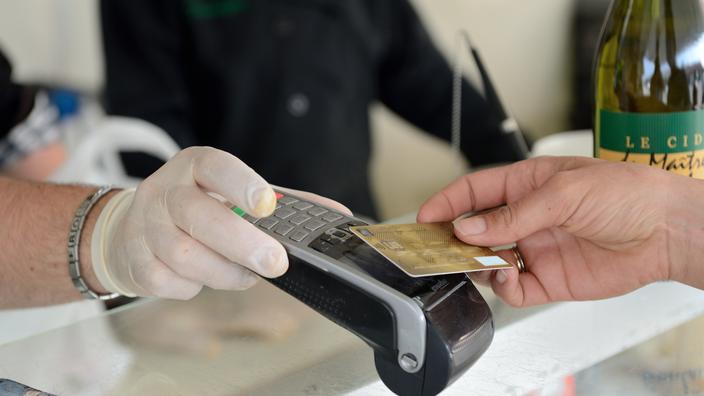If households consumed less last year due to lockdowns and successive curfews, the bank card has not suffered as much from this drop in purchases as expected.
In value, the French spent 490 billion by credit card in 2020. A figure down only 1.5% compared to the previous year according to the Banking Cards group, because the health crisis has increased the use of contactless and online payments; and the average shopping basket has increased.
Read also: 2020, the year when “contactless” payment dethroned cash
Not surprisingly, the successive lockdowns and curfews have clearly favored the payment of goods and services online.
The number of CB payments in distance selling and e-commerce grew by 12% last year.
“
From April, online payments increased sharply, driven by specialized goods, but also by the use of drives implemented by large-scale distribution, and later, by independent businesses
”, observes Loÿs Moulin. , Director of Development at the Cartes Bancaires group.
In value, e-commerce concentrated around 22% of all CB payments in 2020.
The meteoric rise of contactless payment in 2020
The health crisis has also pushed the use of contactless payment.
Transactions through this channel reached 4.6 billion in 2020, compared to 3 billion in 2019, and 60% of payments under 50 euros made in stores were made in contactless mode.
From a health point of view, "
consumers have been particularly seduced by this technology, because it allows the keys of the TPE not to be touched
", points out Loÿs Moulin.
Moreover, according to the barometer carried out by the research firm Kantar for the Bank Cards group (*), 20% of respondents said they had used contactless payment for the first time in 2020, the main reason being the desire to respect barrier gestures.
Another factor in this meteoric progression: the raising of the ceiling from 30 to 50 euros at the end of the first confinement.
Last January, contactless represented 38% of CB payments, a rate which rose to 45% in May 2020. “
The reopening of non-essential businesses on May 11 necessarily benefited contactless payment, but the increase in the ceiling was also a factor in accelerating its use,
”assures the group's development director.
This phenomenon intensified in the months that followed: in June, 49% of credit card payments were made without contact, and reached 52% in December.
A higher average basket
However, the number of CB transactions fell by 5% in 2020 compared to the previous year.
The virtual stability of the amount spent between 2019 and 2020 is therefore not explained by an increase in the number of transactions, but by their value.
In 2020, the average basket was 41 euros, ie 1 euro more than in 2019. According to Loÿs Moulin, “
that doesn't seem like much, but it's the opposite trend to that observed since 2012. It has been 7 years since was dropping every year
. ”
How to explain this slight increase?
“
The French did their shopping, especially food, less regularly and therefore spent more each time.
In addition, during the first confinement, it was necessary to fill up to feed the whole family all week,
”he analyzes.
Read also: Adolescents, the new target of mobile banks
Lastly, CB payments have particularly increased in online catering, a sector where "
they have recorded 3-digit growth, thanks to the explosion in delivery and take-out
", underlines Loÿs Moulin.
This reality can be seen in the number of transactions carried out with dematerialized meal vouchers, which doubled in 2020, reaching 70 million.
Because if all did not offer an offer combining table service, delivery and take-out at the start of the health crisis, "
a number of restaurants have adapted between the two confinements
", he observes.
(*)
Barometer carried out from November 2 to 9, 2020 on a representative national sample of 1,100 individuals aged 15 and over.

